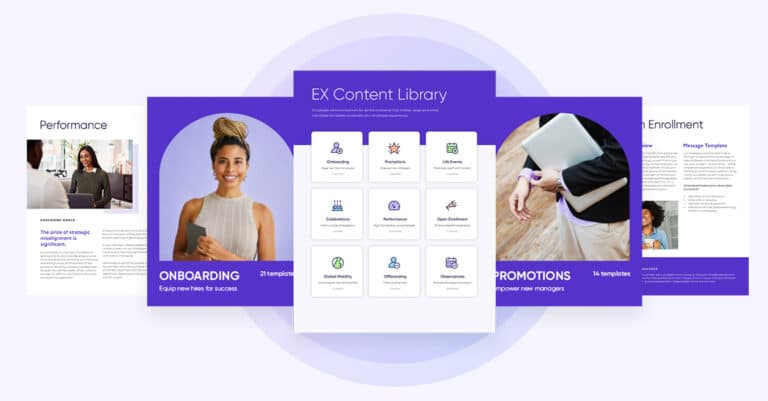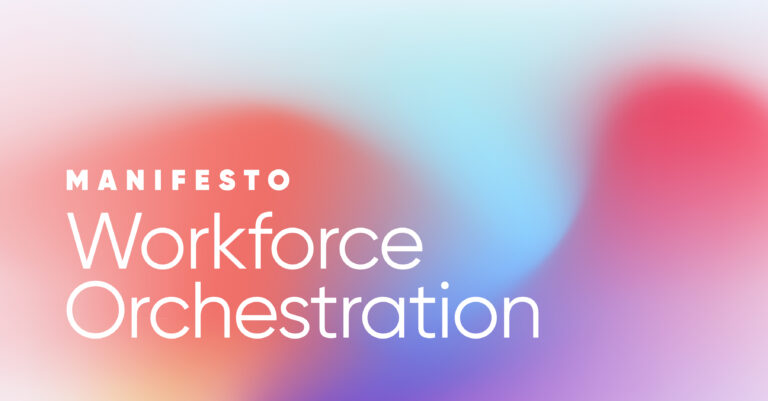People are the core of your organization, and Human Resources (HR) is the bridge connecting employees to leadership. But often that connection is broken, leaving employees and other stakeholders confused and disengaged. This is why every HR department and People Leader needs to have effective HR communication strategies in place, to ensure the success not only of the organization but individual team members, as well.
Read on to learn how to improve HR communication and build an effective communication strategy tied to internal communications.
Surprising HR communication statistics
A recent Gallup study found that nearly 85% of employees globally are not engaged or are actively disengaged at work. That’s partly because companies make the mistake of only occasionally putting in the effort to make employees feel engaged and because leadership has not implemented smart HR communication strategies in the first place.
Organizations that improve communications may increase their productivity by 23% according to Gallup—which could contribute to $1.3 trillion potential revenue annually.
The cost of poor comms is high. A recent survey of business leaders and knowledge workers, State of Business Communication, estimated that poor communication could amount to $1.2 trillion in annual losses for U.S. businesses, which amounts to over $12,000 per employee per year.
That survey also showed that 75% of business leaders believed their team struggled with communicating effectively!
On top of that, nearly 50% of employees and 53% of managers feel burnt out, suffering from ‘communications overload’ as companies try to keep them informed through continuous emails, alerts, and meetings.
And if you think employees might get some relief from the traditional intranet, think again: 80% of the global workforce that is deskless has very limited access to the company intranet.
Employees who feel their voice is heard are 4.6 times more likely to be empowered to perform their best work, and a 5% increase in employee engagement can lead to a 3% jump in a company’s revenue.
The importance of HR communication for employee retention and more
Every organization or company relies on effective communication to grow and achieve strategic business goals. It expresses the company’s values and priorities as it connects with external groups (including customers) and internal stakeholders (mainly employees).

Often, Human Resources professionals are the ones who communicate the most critical messages about such things as HR policies, onboarding, company overviews, benefits, salaries, and company policies (and that’s just a partial list). In essence, HR communications can either make or break an organization.
How HR can work with comms to improve the employee experience
Internal communicators and HR leaders, in today’s working environment, have an opportunity to work together on the shared goal of improving the employee experience far beyond what the business silos of the past afforded them. They can do this by:
- Aligning on goals: When all communications being sent to employees is on-brand, on-message, and consistent, it helps to connect employees to work towards a common goal
- Sharing persona information: An intelligent communication platform can help build and analyze employee personas so that HR and internal communications can create and deliver targeted messages and initiatives.
- Collaborating on employee wellness: With the increase in wellness programs in most companies, HR and internal comms can ensure wellness and mental health programs are designed to meet the needs of new hires and long-term employees alike.
- Encouraging two-way communication and feedback: HR and communications can work together to gather, organize, present, and act on feedback to engage employees and build workplace culture.
- Transparency on changes and updates: Collaboration on regular, timely updates on company news, new policies, and workplace initiatives helps build trust.
By working together, HR communication teams and internal communications become a trusted source of information that puts everyone on the same page and understands employee needs, their concerns, and creates a positive, friendly workplace and company culture that focuses on the employee experience.

7 reasons why HR communication is important to a successful company
#1: Communicates messages to stakeholders
Human Resources and internal communicators can be extensively used to communicate messages to internal stakeholders about the state of the organization (think investor news or training and development policies). This helps management and employees make better and more informed decisions on how to grow the organization. It also helps make sure everyone is aligned with company goals.
#2: Helps a company to achieve its objectives
Human Resources communications go a long way in helping a company to achieve its goals, make the organization better organized from the inside, and propel it to achieve its objectives. Without alignment, business initiatives may fail.
Additionally, HR provides a communication strategy to be the trusted advisor to leadership and employees.
#3: Critical in an organization’s strategic plan
If an organization has a strategic communications plan that will help it make huge leaps towards growth, HR should prepare, implement, and execute the strategy.
According to Princeton University, the HR communications team oversees the strategic planning and delivery of all HR communications. These communications, in their case, include their graphic identity, their HR newsletter, and the content on their website. The organization also has, or may need to, adopt these strategies and an HR communications team will be relevant in their execution.
#4: Builds trust
For an organization to run well and efficiently, communications must be well-organized, clutter-free, and truthful. Today, truth and trust in internal communications are critical to helping employees cut through the clutter and feel confident about their daily effort, which builds employee engagement.
The HR communications team should offer employees first-hand, accurate, and reliable information about wages and benefits, organizational policies and rules, company news, and other vital HR issues to support a positive company culture. Without this trust, employees may get the wrong information from outside the company or believe in rumors.

#5: Keeps employees connected
The value of your employees extends well beyond what you pay them in salary. Employees need to feel appreciated and recognized, no matter what number appears on their paychecks.
HR communications can help make employees feel like they matter to the organization, giving them the information they need to thrive, such as how the company works, the benefits of contributing their best effort to the company, any training opportunities, and policy changes.
The Firstup intelligent communication platform helps leaders improve HR communication by designing moments across the entire employee journey via connecting human resources systems, reducing digital noise, boosting engagement, and providing intelligent data to spot and take action on problems before they arise.
#6: Plans for future success
A strong vision of future success must drive HR communications. After all, the organization’s future depends on how well its workforce can anticipate and adapt to change. The efforts of the HR department can help the workforce stay informed, focused, and receptive to change.
Typically, most organizations train staff members and equip them with the skills necessary to work better and more efficiently. HR communications chip in and make the training materials fun-oriented, more accessible, and more informative to the trainees. Moreover, this smoothens the internal communication process by redesigning the communication materials.
HR communication is also vital in engaging employees, maintaining good company culture, and boosting both the individual employees and the organization.
#7: Increases employee creativity and motivation
To get the most value from the creative powers of your employees, you must make sure they’re motivated to perform their best every day. Good communication can improve employee creativity by up to 93%, which can, in turn, contribute to improved productivity.
Employees can do better if an HR communications strategy includes initiatives and key messages that offer employee support, recognition, and appreciation.
How to retain employees with HR communication
Employee engagement and retention are key components of a successful HR communications strategy. As an organization grows, it is important to send engaging and compelling messages to keep team members motivated and informed.
If employees don’t know what’s happening and are not aligned with larger strategic business goals, those initiatives may fail.
Moreover, employee retention requires a solid and strategic in-house comms team rather than outsourcing all communications to agencies and consultants.
Employee retention doesn’t stop with the onboarding process for new employees. HR teams need to connect and communicate effectively with their workforce beyond day one because employee engagement, productivity, workplace culture, and the bottom line are at stake.

The future of human resources and internal communications
With so much at stake for organizational success, leaders must improve their HR communication strategy and prioritize engaging employees. The first step is to audit how you’re currently communicating with employees, measure the data tied to the performance of those comms, and work to better understand your employees with insights that can improve engagement, productivity, and retention.
Traditionally, measurement and metrics have been an unexplored territory for communicators. According to our research about mobile and intranet practices among communications professionals, only 44% of survey respondents looked at email clicks (with email newsletters as a common way to communicate with employees); and 19% didn’t track metrics for employee communications at all.
Additionally, only 22% of communicators were confident that the metrics they were tracking were effective in improving their communications.
How metrics helped an HR team gain high levels of open enrollment activity
Here’s how much metrics can make a difference to the strategic goals of HR departments and communications teams.
Recently, a multinational company with 52,000 employees was planning for open enrollment. Because of the size of their organization and the number of deskless workers, communicating open enrollment was incredibly time-consuming and challenging.
They used every means possible to reach employees—email, intranet, flyers in break rooms, and more. However, the HR and communications teams could not monitor whether employees received the information. As a result, many workers missed the open enrollment deadlines and the opportunity to make benefits changes.
Determined not to repeat that outcome, the company used Firstup the following year to publish and distribute open enrollment information. They could target employees with benefits information tailored to their needs, including automated reminders.
The company saw a 110% gain in open enrollment activity from the previous year, and the Firstup platform saved the HR team countless hours.

A lack of confidence in measuring internal communications and a lack of data savviness can have negative consequences for companies. The bottom line is, HR professionals aren’t using data-based insights to improve their strategies. We discovered that a staggering 70% reported that leadership didn’t even ask for metrics from HR.
Their employee communications data was given very little attention—and, in some cases, ignored completely.
How to improve HR communication in the workplace
- Improve employee engagement by studying your employees. Learn who they are and what communications channels they prefer. By taking this first step in understanding your audience (much like a marketer who analyzes the customer journey), you’ll be able to reach and meet expectations and drive employee engagement. (Use our employee persona template to start studying your workforce.)
- Evaluate your current HR communication channels. What’s working, and what leads to ineffective communication? Standalone internal communications tools don’t work as well as an integrated, intelligent communication platform. So your email and intranet alone will not reach your workers over time in the same way as a system that integrates all your channels in one central location.
- Create a multi-channel internal communications approach to reaching your employees and team members. This allows you the flexibility to reach workers on their preferred channel, and you’ll engage deskless and frontline employees (who may not have easy access to email or the intranet) that prefer a mobile app for your company.
- Align your internal communications strategy to larger business objectives and goals.
- Measure internal communications content performance. If necessary, start small. Consider what KPIs and metrics are essential to understand what success looks like. Track this data over time, collect employee feedback, and then share it with your team and leaders.
- Turn your internal communications data into action. Create a story with your data to learn how you met your goals (or where you didn’t). You can’t truly improve without continuously checking your metrics.
Enable effective HR communications with the first intelligent communication platform
Firstup helps you build a more sustainable workforce across your organization, from HR and comms to IT and leadership, by reducing digital noise, fostering alignment, increasing productivity, creating more meaningful and engaging communication, and a better understanding of your employees.











